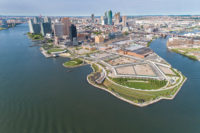New York City
When the Academy for Careers in Television & Film (ACTvF) learned it would be one of three schools coming into a brand-new facility with spectacular views of Manhattan, both students and staff felt as if they had won the lottery. At the time, the city public school was located in the basement of a rundown building in Astoria, Queens. “It’s an extreme upgrade,” says Alan Metzger, a former television director, who cofounded ACTvF in 2008. “We are the American Dream—we went from the basement to the penthouse in five years.”
The facility can accommodate more than 1,000 students dispersed among the three schools. In addition to the high school, the building contains the newly created Hunter’s Point Community Middle School, with an ecology focus, and the Riverview School for special-education students. Located on a former industrial site, most classrooms—along with the light-filled hallways, library, and cafeteria—treat students to a sweeping panorama of the Manhattan skyline. “Even though it’s an urban school, we’ve tried to make it feel as if it’s part of a dynamic landscape,” says FXFOWLE senior partner Sylvia Smith. “The challenge was creating a narrative that reflected this amazing site.”
Just one subway stop from Grand Central Station in Manhattan, Hunter’s Point South is a rapidly developing 30-acre neighborhood in the borough of Queens, where mixed-income residential towers are rising alongside retail shops and office spaces. The five-story, 145,000-square-foot school, which opened in the fall of 2013—along with a beautifully manicured 5.5-acre park designed by Weiss/Manfredi—are two of the public amenities in the master plan meant to support the influx of new families to the area.
A bold move for the city’s school system, the dynamic new building riffs on the traditional school box. FXFOWLE chipped away at the solid form to bring in daylight, carving a terrace across the top floor and slicing glazed wedges down through the brick to bring light into the corridors. For extra punch, Smith and her colleagues defined the voids, including the cantilevered roof canopy, with bright orange metal panels, and wrapped the ground-floor gymnasium with translucent fiberglass panels. Says Smith, “It needed to have muscle and weight, but we also wanted a certain sculptural, artistic quality.”
The architect’s chief goal was maximizing light and views, which was a challenge because of the idiosyncrasies of the L-shaped site, which hugs two sides of a residential tower (under construction). Working from the inside out, they inserted the auditorium into the core of the third and fourth floors and tucked many of the mechanical and storage spaces into the wedge occupied by the neighboring tower, allowing them to position the classrooms around the building’s perimeter.
Metzger says this layout has been a tremendous success. “One thing that really works about this building is the flow patterns,” he says. “In our old space, we had one central hallway, and it was so crowded—it was impossible for students not to run into each other.” He says that in the new structure, the light and airy corridors act as small plazas where students can congregate without creating a bottleneck. Smith compares the auditorium to a rock in a stream, with circulation flowing around it.
The most daring aspect of the architect’s scheme was bringing the cafeteria to the top of the building. With the terrace, it gives the students an uplifting place to have lunch and hang out, and the administration uses the space for parent meetings and events. “The idea of putting the gym on the ground floor and the cafeteria on the fifth floor was marvelous,” says Edgar Rodriguez, the high school principal. “Instead of doing what was cheapest or most expedient, engineering-wise, they figured out how to best use this location. It’s the signature of the building.”
For a high-profile project on a coveted site, the school system took a risk and hired a top-flight architecture firm that had never built a public school in New York City from the ground up. “You can’t even put a value on it, it’s so fabulous,” says Rodriguez. “We have the most beautiful school building in the whole city.”
People
Owner:
Architect:
Personnel in architect's firm who should receive special credit:
Project Managers:
Jiyoung Lee, AIA, LEED
Engineers:
M / E / P / FP:
Site-Civil / Landscape / Geotechnical:
Consultant(s):
Acoustical:
General contractor: Size: 145,000 square feet Cost: $61 million Completion date: August 2013 |
Products
Structural system
Exterior cladding
Metal Panels:Alucobond:
Metal / glass curtain wall:
Rainscreen: Alucobond:
Moisture barrier:
Curtain wall:
Other cladding unique to this project: Cold Spring Granite:
Roofing
Other:American Hydrotech:
Windows
Glazing
Insulated-panel or plastic glazing:
Doors
Metal doors:
Wood doors:
Hardware
Closers:
Exit devices:
Security devices:
Interior finishes
Suspension grid:
Cabinetwork and custom woodwork: Patella:
Paints and stains:
Wall coverings:
Paneling: Decoustics Solo 8:
Plastic laminate:
Solid surfacing:
Floor and wall tile: First Floor Lobby/ Corridors, Stair Landings Porcelain Tile:
Resilient flooring:
Carpet:
Lighting
Task lighting:
Exterior:
Conveyance
Accessibility provision:
Plumbing
Other unique products that contribute to sustainability: |












